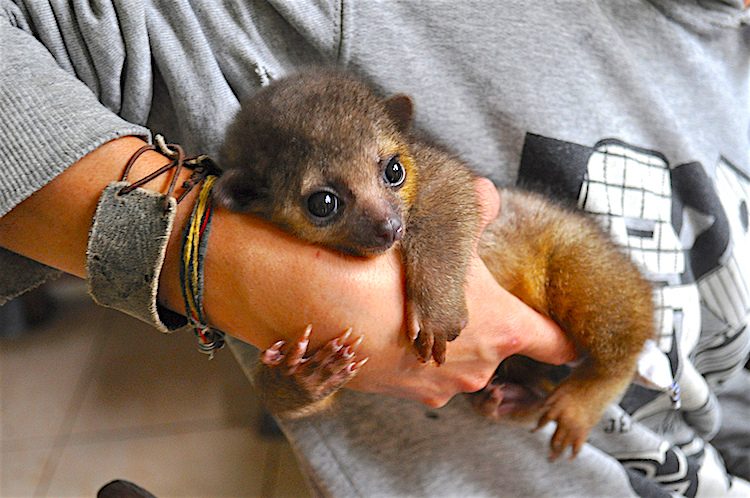
Kinkajous are small mammals that are native to the rainforest.
They’re intelligent, vocal and curious animals — and they’re among the latest in the growing trend of exotic pets.
Kinkajous grow to be 2–12 pounds, depending on their subspecies, and can live for roughly 20 years. In other words, this is not a short-term pet.
Kinkajous are unarguably cute animals — but whether or not they make good pets remains to be seen.
Let’s take a look at the kinkajou to see how this mammal fits into the average household.
Environment
Natives of the rainforests, these mammals are used to warm climates.
They are tree climbers assisted by their strong, lengthy tails, which they use as a balancing aid and to grip branches while they hang down.
Kinkajous spend most of the time up in the trees where it’s safer, often using interconnecting branches to travel from tree to tree.
The kinkajous’ paws are able to rotate to allow them a better grip on branches while they travel.
Their paws are nimble and equipped with sharp claws. The paws are similar to those of their close relatives, raccoons, although there are some differences. For example, the kinkajou can hang from its tail and use its paws to eat, but a raccoon cannot.
Diet
Kinkajous are omnivores with a widely varied diet in the wild.
They use their long tongues to scoop honey from bees’ nests and insects from their hills with canine-like teeth.
Kinkajous will also eat fruits, small mammals and eggs. In captivity at zoos, these mammals are often fed a mixture of dog food, fruits and sometimes corn.
Social Behavior
Kinkajous spend plenty of time alone. While they travel to look for food, they generally stick to their own territories, which they mark with scent glands in their abdomen and mouth areas.
When together in a group, kinkajous will groom one another, play, sleep and search for food together.
Females give birth to 1 offspring (occasionally 2), which she will leave in a tree hollow while she searches for food. Her young will stay with her for 18–24 months, with male offspring having a tendency to leave her side slightly earlier than female offspring.
Kinkajous are extremely vocal. They use a mixture of high-pitched screeches, hisses and barks to communicate. Because they are nocturnal, most of their vocalization happens at night.
The kinkajou tends to form a strong bond with their person. They need to be socialized from a young age in order to keep aggression in check.

Kinkajous at Home
Armed with this basic information about kinkajous, we can see some considerations people should take into account before bringing one home as a pet:
- Nocturnal: These animals are active at night.
- Vocal: They tend to chatter.
- Territorial: They mark their territory.
- Environment: They are accustomed to warm climates with plenty of climbing space available.
- Nimble: Their “fingers” resemble those of raccoons, who are notorious for cleverly getting into places they shouldn’t.
So, if you’re thinking of bringing a kinkajou home, consider how you will house your new pet and whether you’ll be able to provide a large, comfortable space with plenty of climbing areas.
Think about how you will maintain a comfortable temperature and have a backup plan for power outages.
Consider your lifestyle. If you work days and need to sleep nights, these animals may not fit into your lifestyle. Apartment living and home sharing will likely not be a good fit for kinkajous unless everyone in the immediate area is willing to share their sleeping hours with a wakeful pet.
If you plan to allow your kinkajou to roam the house freely, you’ll need to spend a great deal of time “pet proofing” to prevent access to electrical wires and outlets, poisonous plants, cleaning supplies, garbage bins and more. The animal’s curiosity and clever fingers make for a dangerous mix in an unsupervised environment.
You’ll also need a plan in place to deal with their territorial marking, which will be difficult to stop — and these animals are difficult, if not impossible, to litter train.
Kinkajou Care
It may be difficult to find an exotics veterinarian in your area who is comfortable caring for your kinkajou.
Kinkajous can carry the Baylisascaris procyonis roundworm, which can be transmitted to humans through fecal contact, so remember to wash your hands a lot.
They can also catch rabies and distemper, so vaccinations are a must, as well as spaying/neutering.
This kinkajou is a true member of this family:

Kinkajous and the Law
There are laws in place regarding kinkajous. These laws will vary widely by state and sometimes even by municipality or town.
Before getting a kinkajou, check with your state to find out whether these exotic pets are allowed and, if so, whether you need a permit. Then check with your town to ensure there are no bylaws preventing you from keeping a kinkajou.
Kinkajous can make good pets — for the right person. They are not easy to re-home because of the bond they form with their human. The kinkajous’ long lifespan means you’ll be committing to your pet’s care for the next 20 years, so this is a huge decision.
Kinkajou care is not for the faint of heart. But if you can commit, your kinkajou could bring you a lifetime of love.


